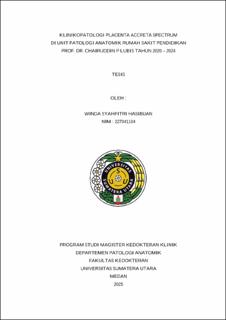| dc.description.abstract | Objective: To determine the clinicopathological characteristics of placenta accreta spectrum (PAS) at Rumah Sakit Pendidikan Prof. Dr. Chairuddin Panusunan Lubis Medan in 2020-2024.
Methods: This is a descriptive categoric study with a cross-sectional approach. Data collection was carried out retrospectively using secondary medical record data with a total sampling technique that met the inclusion and exclusion criteria. The subjects of the study were slides from patients with PAS with uterine and placental specimens in situ examined for histopathological diagnosis with Hematoxylin & Eosin staining. Data processing and analysis were carried out using categorical descriptive statistical tests, with the Statistical Package for the Social Sciences (SPSS).
Results: Of the 32 specimens, the most common PAS age group was 30-40 years as many as 23 cases (71.88%), history of parity > 1 time as many as 27 cases (84.38%), history of cesarean section 2 times as many as 18 cases (56.25%), history of other operations as many as 9 cases (28.12%), history of uterine disease as many as 21 cases (65.62%). The most common villous invasion depth was placenta increta as many as 16 cases (50%), loss of decidua was seen in all specimens, chronic inflammation of the myometrium and the presence of villi in the intravascular were only seen in 5 cases (15.62%) and 6 cases (18.75%). Frequency distribution of the villous invasion depth based on the age was highest at 30-40 years in the entire spectrum, based on history of cesarean section 2 times most occurred in placenta accreta 5 cases (45.45%), increta 9 cases (56.25%) and percreta 4 cases (80%), history of other operations occurred in 6 cases (37.5%) of placenta accreta and increta, and 1 case (20%) in placenta percreta, history of uterine disease occurred in placenta accreta as many as 7 cases (63.64%), placenta increta 10 cases (62.6%), and placenta percreta 4 cases (80%). Loss of decidua was seen in the entire PAS spectrum. Chronic inflammation of the myometrium and the presence of villi in the intravascular were most common in placenta increta as many as 4 cases (25%) and 5 cases (31.25%).
Conclusion: The frequency distribution of PAS patients is most often found in patients with the age group of 30-40 years, parity >1 time, history of cesarean section 2 times, history of other operations and history of other disease in the uterus. In this study, loss of villi was seen in all specimens, the depth of villi invasion was greatest in placenta increta, chronic inflammation in the myometrium and the presence of villous tissue in the intravascular only appeared in a small portion of specimens. | en_US |


